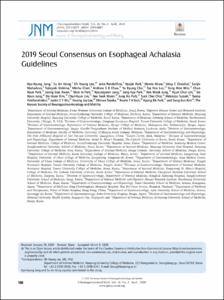KUMEL Repository
1. Journal Papers (연구논문)
1. School of Medicine (의과대학)
Dept. of Internal Medicine (내과학)
2019 Seoul Consensus on Esophageal Achalasia Guidelines
- Keimyung Author(s)
- Park, Kyung Sik
- Department
- Dept. of Internal Medicine (내과학)
- Journal Title
- Journal of neurogastroenterology and motility
- Issued Date
- 2020
- Volume
- 26
- Issue
- 2
- Abstract
- Esophageal achalasia is a primary motility disorder characterized by insufficient lower esophageal sphincter relaxation and loss of esophageal peristalsis. Achalasia is a chronic disease that causes progressive irreversible loss of esophageal motor function. The recent development of high-resolution manometry has facilitated the diagnosis of achalasia, and determining the achalasia subtypes based on high-resolution manometry can be important when deciding on treatment methods. Peroral endoscopic myotomy is less invasive than surgery with comparable efficacy. The present guidelines (the "2019 Seoul Consensus on Esophageal Achalasia Guidelines") were developed based on evidence-based medicine; the Asian Neurogastroenterology and Motility Association and Korean Society of Neurogastroenterology and Motility served as the operating and development committees, respectively. The development of the guidelines began in June 2018, and a draft consensus based on the Delphi process was achieved in April 2019. The guidelines consist of 18 recommendations: 2 pertaining to the definition and epidemiology of achalasia, 6 pertaining to diagnoses, and 10 pertaining to treatments. The endoscopic treatment section is based on the latest evidence from meta-analyses. Clinicians (including gastroenterologists, upper gastrointestinal tract surgeons, general physicians, nurses, and other hospital workers) and patients could use these guidelines to make an informed decision on the management of achalasia.
- Keimyung Author(s)(Kor)
- 박경식
- Publisher
- School of Medicine (의과대학)
- Citation
- Hye-Kyung Jung et al. (2020). 2019 Seoul Consensus on Esophageal Achalasia Guidelines. Journal of neurogastroenterology and motility, 26(2), 180–203. doi: 10.5056/jnm20014
- Type
- Article
- ISSN
- 2093-0887
- Source
- http://www.jnmjournal.org/journal/view.html?doi=10.5056/jnm20014
- DOI
- 10.5056/jnm20014
- Appears in Collections:
- 1. School of Medicine (의과대학) > Dept. of Internal Medicine (내과학)
- 파일 목록
-
-
Download
 oak-2020-0428.pdf
기타 데이터 / 1.52 MB / Adobe PDF
oak-2020-0428.pdf
기타 데이터 / 1.52 MB / Adobe PDF
-
Items in Repository are protected by copyright, with all rights reserved, unless otherwise indicated.